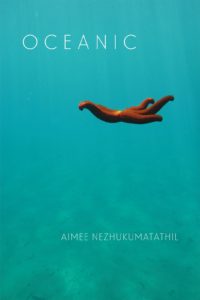
I’ve been following Aimee Nezhukumatathil’s career since her first book, and her latest, Oceanic (released this April from Copper Canyon Press), is her strongest, most confident writing yet. It’s been seven years since her last book of poems, Lucky Fish (Tupelo Press, 2011), and I believe she channeled her energy during that time into this powerful volume packed with intimate details of the creatures of the earth, as well as the passions of the speaker’s (and presumably the writer’s) life. Nezhukumatatil engages with wide-ranging subject matter—pop music, art, science, mythology, and even disturbing topics like child trafficking—in a variety of forms. Despite its title, Oceanic is much more than a love letter to the ocean. Full of poems that are passionate about the environment without being preachy, that beautifully name and describe the natural world, and that honor self, love, and family, Oceanic is a celebration of nature and of life itself.
Despite the wide-ranging subject matter, the book is not divided into sections. Instead, the poems function as a unified whole, beginning with the epigraph from oceanographer Sylvia Earle: “No water, no life. No blue, no green.” From the beginning pages of the collection, Oceanic’s speaker projects a confident voice about being an “outsider” in poems like “In Praise of My Manicure”:
Because I was taught all my life to blend in, I want
my fingernails to blend out…like red starfish who wiggle a finger dance at you,
like green-faced Kathakali dancers who shapetheir hands into a bit of hello with an anjali…
…if the bright colors and glittered stars of my fingertips scare you,
I will shape my fingers into sarpasirassu—my favorite,a snake…just look at these colors so marvelous so fabulous…
The beauty and the threat of the snakes captivates the speaker as she continues:
See the two snakes where my brown arms once were…
A snake heart can slide up and down the length of its body
when it needs to. You’ll never be able to catch my pulse, my shine.
The speaker’s embrace of her bright nails and “brown” arms, her delight in “my pulse, my shine,” and the snake imagery all celebrate a unique heritage and family history. The speaker no longer wants to “blend in” but “blend out.”
Nezhukumatathil has always been a skilled observer of nature, celebrating the natural world for its wonders and unique characters. In Oceanic, the idea of impending threats—to the ocean, to each vulnerable species, to humanity—is a counterpoint to this celebration. In “The Body,” the speaker’s own nails and the lives of sea stars are both endangered and dangerous:
Something poisons the sea stars
in the Pacific. They rip themselves apart,
twist their arms in gummy knots……I want to pull off my arm…Yes—that’s
what I’d get rid of—my nail now blackened
with each thump of a sentence.
This threat also extends to her family, and to fellow humans across the globe, in “Two Moths” and “Love in the Time of Swine Flu.” From the latter:
…I fever for the prickled pain
of lip-bite and bed burn. You get up and comeback to bed. We decide it is worth it….The child still forming
inside me fevers for quiet, the silence of the after,
the silence of cell-bloom within our blood.people will see her will hear her…
“Two Moths” make the startling and heartbreaking jump from girls involved in sex trafficking to the image of beautiful moths:
…Men shove greasy rupees at the door
for one hour in a room
with a twelve-year-old…And if she cries afterward
Her older sister will cover it up. Will rim
the waterline of her eyes with kohl pencil
until it looks like two popinjay moths
have stopped to rest on her exquisite face.
While Nezhukumatathil engages with dark themes in this book, she isn’t afraid to spend time on small moments of beauty and humor. Some of the funnier moments in the book come from the found poems made up of one-star Yelp reviews of some of the seven wonders of the world. From “One-Star Reviews of the Taj Mahal”:
The garden is very basic. Everything is basic… I was told to get out with my selfie stick!… Can you believe this tomb has no rides?
There are also praise poems throughout the book, like the opening poem, “Self-Portrait as Scallop,” which begins with the startling lines: “Let me see your shadow / feather across / my hundred blue eyes.” Or the penultimate poem of the book, “My South,” which begins “My south started with sugar / boiled and spilled for birds / green as my mom’s signature ring…” and concludes with the comfort and relief of “and even on my first day, never asked / if I’m from around here or just visiting.” “Penguin Valentine” is a funny and touching love poem in which the speaker imagines separation from her husband in the figure of a lone male penguin.
Beyond these poems of humor and praise, Nezhukumatatil utilizes a variety of forms in Oceanic. My favorites were those in the haibun form, especially “End-of-Summer Haibun,” which describes the birth of a child with lovely imagery:
To everything there is a season of parrots… Salamanders use the stars to find their way home…You were born on a day of peaches splitting from so much rain… .
Nezhukumatatil offers this collection to explore, and to make a case for, connection—between her speaker and others, between humans and sea creatures, and between ourselves and the universe. We see this in poems like “Naming the Heartbeats”:
When you get a group of heartbeats together, you get names that call out into the evening’s first radiance of planets: a quiver of cobras, a maelstrom, of salamanders, an audience of squid, an ostentation of peacocks….
From sea stars to elephant tigers, from her children and husband to the speaker’s own scars, Oceanic conveys a rare sense of awe and unsentimental passion for the earth, its creatures, and the universe.





